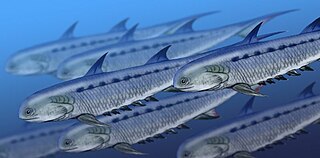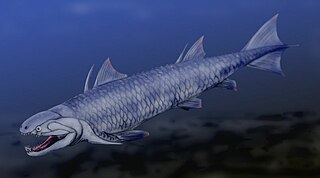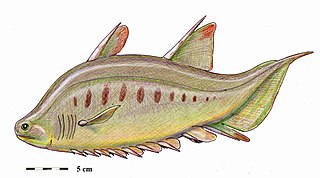
Chondrichthyes is a class of jawed fish that contains the cartilaginous fish or chondrichthyians, which all have skeletons primarily composed of cartilage. They can be contrasted with the Osteichthyes or bony fish, which have skeletons primarily composed of bone tissue. Chondrichthyes are aquatic vertebrates with paired fins, paired nares, placoid scales, conus arteriosus in the heart, and a lack of opecula and swim bladders. Within the infraphylum Gnathostomata, cartilaginous fishes are distinct from all other jawed vertebrates.

Acanthodii or acanthodians is an extinct class of gnathostomes. They are currently considered to represent a paraphyletic grade of various fish lineages basal to extant Chondrichthyes, which includes living sharks, rays, and chimaeras. Acanthodians possess a mosaic of features shared with both osteichthyans and chondrichthyans. In general body shape, they were similar to modern sharks, but their epidermis was covered with tiny rhomboid platelets like the scales of holosteians.

Cladoselache is an extinct genus of shark-like chondrichthyan from the Late Devonian (Famennian) of North America. It was similar in body shape to modern lamnid sharks, but was not closely related to lamnids or to any other modern (selachian) shark. As an early chondrichthyan, it had yet to evolve traits of modern sharks such as accelerated tooth replacement, a loose jaw suspension, enameloid teeth, and possibly claspers.

Stethacanthus is an extinct genus of shark-like holocephalians which lived from the Late Devonian to Late Carboniferous epoch, dying out around 298.9 million years ago. Fossils have been found in Australia, Asia, Europe and North America.

Climatius is an extinct genus of spiny shark. This genus is known from the Early Devonian (Lochkovian) of Europe, previously considered Silurian remains actually belong to Nostolepis instead.

Mesacanthus is an extinct genus of acanthodian fish from Devonian Scotland. It is among the more primitive of the Devonian acanthodians.

Cheiracanthus is an extinct genus of a group of fish called Acanthodii. It was a deep-bodied acanthodian about 12 in. (30 cm) in length. It had a blunt head, upturned tail, and fins protected by spines. Unlike many other acanthodians, it had one, solitary dorsal fin. Cheiracanthus swam at mid-depth in lakes and rivers, seizing small prey in its gaping jaws. Whole fossils of this fish occur only in Mid-Devonian rocks in Scotland, but its distinctive small, ornamented scales crop up around the world, as far south as Antarctica.

Psarolepis is a genus of extinct bony fish which lived around 397 to 418 million years ago. Fossils of Psarolepis have been found mainly in South China and described by paleontologist Xiaobo Yu in 1998. It is not known certainly in which group Psarolepis belongs, but paleontologists agree that it probably is a basal genus and seems to be close to the common ancestor of lobe-finned and ray-finned fishes. In 2001, paleontologist John A. Long compared Psarolepis with onychodontiform fishes and refer to their relationships.

Ischnacanthus is an extinct genus of jawed fish in the class Acanthodii. It lived during Pridoli to Lochkovian, type species I. gracilis is only known from Lochkovian.

Hybodontiformes, commonly called hybodonts, are an extinct group of shark-like cartilaginous fish (chondrichthyans) which existed from the late Devonian to the Late Cretaceous. Hybodonts share a close common ancestry with modern sharks and rays (Neoselachii) as part of the clade Euselachii. They are distinguished from other chondrichthyans by their distinctive fin spines and cephalic spines present on the heads of males. An ecologically diverse group, they were abundant in marine and freshwater environments during the late Paleozoic and early Mesozoic, but were rare in open marine environments by the end of the Jurassic, having been largely replaced by modern sharks, though they were still common in freshwater and marginal marine habitats. They survived until the end of the Cretaceous, before going extinct.

Fins are moving appendages protruding from the body of fish that interact with water to generate thrust and help the fish swim. Apart from the tail or caudal fin, fish fins have no direct connection with the spine and are supported only by muscles.

The evolution of fish began about 530 million years ago during the Cambrian explosion. It was during this time that the early chordates developed the skull and the vertebral column, leading to the first craniates and vertebrates. The first fish lineages belong to the Agnatha, or jawless fish. Early examples include Haikouichthys. During the late Cambrian, eel-like jawless fish called the conodonts, and small mostly armoured fish known as ostracoderms, first appeared. Most jawless fish are now extinct; but the extant lampreys may approximate ancient pre-jawed fish. Lampreys belong to the Cyclostomata, which includes the extant hagfish, and this group may have split early on from other agnathans.

Brochoadmones is an extinct genus of acanthodian from the Devonian of what is now Canada. It is the only genus in the suborder Brochoadmonoidei, whose relationship to other acanthodian orders remains currently in flux.

Antarctilamna is an extinct genus of Devonian cartilaginous fish originally exemplified by Antarctilamna prisca from South Eastern Australia and Antarctica. The latest occurring described species is Antarctilamna ultima from the Waterloo Farm lagerstätte in South Africa. Antarctilamna has robust ctenacanthid-like spines which lack a deep insertion area, and are borne in front of the first dorsal fin; in addition to distinctive diplodont teeth with small intermediate cusps. Antarctilamna-like spines, known from the Bunga Beds locality in Australia have been ascribed to A. prisca.

Gyracanthides is an extinct genus of acanthodian gnathostome, known from Devonian to Early Carboniferous.

Ptomacanthus is an extinct genus of spiny shark, an early relative of living cartilaginous fishes.

Diplacanthus is an extinct genus of Mid to Late Devonian fish in the class Acanthodii, known as spiny sharks.

Lebachacanthus is a genus of extinct xenacanth known from the late Carboniferous-Early Permian of Europe. During the late Paleozoic, xenacanths were the apex predators of freshwater ecosystems, preying on small amphibians.

Qianodus is a jawed vertebrate genus that is based on disarticulated teeth from the lower Silurian of China. The type and only species of Qianodus, Q. duplicis, is known from compound dental elements called tooth whorls, each consisting of multiple tooth generations carried by a spiral-shaped base. The tooth whorls of Qianodus represent the oldest unequivocal remains of a toothed vertebrate, predating previously recorded occurrences by about 14 million years. The specimens attributed to the genus come from limestone conglomerate beds of the Rongxi Formation exposed near the village of Leijiatun, Guizhou Province, China. These horizons have been interpreted as tidal deposits1 that form part of the shallow marine sequences of the Rongxi Formation.



















